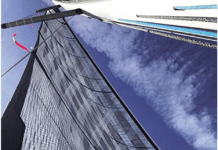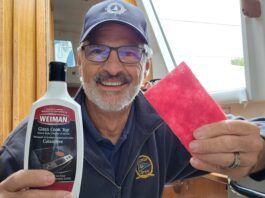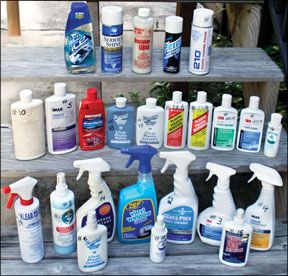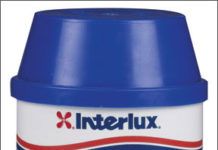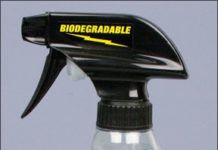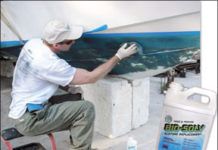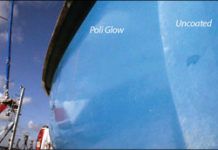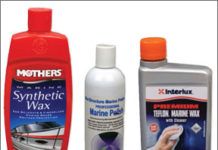PS Advisor: Do Alcohol and Antifouling Mix?
Today I went to paint the bottom of my boat with Interlux’s VC-17m, which I have used since it first came on the market. I had always cut/thinned the paint a bit with acetone. Today, the West Marine store manager (who is an experienced boater) told me that Interlux changed the VC-17m formula and that you should thin it with simple rubbing alcohol. When I used the paint with the alcohol, I noticed that it did not dry as quickly as it had with acetone and seemed thicker than usual after mixing the copper powder. Is it correct that you can now use isopropyl (rubbing) alcohol to "thin" VC-17m antifouling?
The Search is on for the Best Degreaser for Marine Grit and Grime
Practical Sailor searched for the top liquid degreasers to tackle heavy grease on marine stoves and marine engines. Eleven products were tested, including Chomp oil eater, Holy Cow degreaser, Kafko degreaser, Krud Kutter degreaser, Mary Kate Grease Away, Star brite All Purpose Citrus Cleaner Degreaser, and Star brite Sea Safe Cleaner Degreaser. Practical Sailor tested the liquid marine cleaners on grimy fiberglass panels and on aged, greasy farm equipment engines.
Bio-Solv Green Acetone
A bottom-paint job is unpleasant from start to finish, and wiping down the hull with acetone plays a role in that unpleasantness. So when a Cinnaminson, N.J., company sent us an acetone alternative called Bio-Solv, we were more than keen to test it. Bio-Solv is a non-toxic, non-flammable cleaner that works better and is safer than acetone, lacquer thinner, or Xylene, according to Anthony Severino of MAS Epoxies, which began selling Bio-Solv last year. The company buys it from a proprietary manufacturer.
Liquid Wax Test Reaches Six-month Mark
Practical Sailor applied dozens of liquid boat waxes to fiberglass test panels in 2009 to determine which was easiest to apply and was the best for long-term protection of a fiberglass boat. The panels were set out to suffer in the Florida weather for six months, when testers checked in on them to see which waxes still had a gloss and which could still bead water. Topping the marine wax test field in their respective categories were products from Star brite, Cajun Shine All, Collinite, 3M, Nu Finish, Yacht Brite, and West Marine Pure Oceans,. Testers’ top picks for a shiny hull that lasts and is protected from UV damage were the 3M Scotchgard Marine Liquid Wax and Star brite’s Premium Marine Polish.
Exposure Test Results: Varnishes, Teak Oils, and Other Exterior Wood Coatings
Exterior wood finishes-including one-part varnishes, two-part varnishes, synthetics, sealers and stains, and teak oils-were evaluated one year after application. Testers rated the wood finishes on ease of application, the integrity of the gloss and appearance, and how they fared over the 12-month period during which they were exposed to Florida sun and weather. Testers looked at color retention and gloss retention. After a year, 20 of the original 22 one-part varnishes were still performing well, and all six of the original two-part varnishes remained in the running. Varnish alternatives like teak oils and teak sealers struggled to make the 12-month cut, but the Cetol-coated panels still looked good. Products that were doing well 12 months after application included Interlux Cetol Marine and Cetol Marine Light, both with the clear gloss overcoat; Pettit Clear High Gloss and Pettit Wood Finish; Interlux Perfection; and Nautiking NautiThane.
Affordable Marine Antifouling Paint
Practical Sailor tested bottom paints from seven major makers of boat maintenance products. In this report, we compare the 12-month performance of 39 ablative paints and 31 hard paints. We also offer the test results of 18 antifoulings after 24 months in the water, and rate the top specialty antifoulings in specific niches, such as eco-friendly bottom paints, aluminum-safe paints, race-ready antifoulings, fast-drying bottom paints, and budget bottom paints. The bottom paints were tested in both Florida and Connecticut waters. The manufacturers include Alwgrip, Blue Water, Epaint, Flexdel, Interlux, Pettit, and Sea Hawk. Some of the best bottom paints included Epaint EP-21, Pettit Hydrocoat, Epaint ZO, Blue Water Kolor, Interlux Fiberglass Bottomkote, and Sea Hawk Sharkskin.
How Do Acrylic Finishes Hold Up Compared to Boat Waxes?
Our July 2009 issue compared 26 bottled waxes and gave an update on our test of 10 traditional paste waxes. This month, we offer a one-year checkup on acrylic coatings. Acrylic coatings differ from paste waxes in their chemistry and how they are applied. Acrylic finishes penetrate pores and chemically bond to the boats surface. We tracked down seven products, applied them to our blue-hulled test boat, and rated them at the one-year mark. Products tested were Vertglas from Lovett Marine, Poli Glow, NewGlass2, Star brite Glass Cote, Klasse High Gloss Sealant Glaze, Higley FiberGloss Restorer, and Presto Gelcoat Rejuvenator.
Practical Sailor Launches Long-term Liquid Boat Wax Test
With an ever-growing number of boat wax products on the market, Practical Sailor settles on 25 liquid wax products to test for application, initial gloss, and water beading. Marine wax manufacturers included Star brite, Cajun, Collinite, 3M, Mothers, Interlux, Rejex, Imar, Yacht Brite, West Marine, Turtle Wax, and Island Girl. In many ways the waxes all look, feel and smell the same and their differences may be in what the market application the manufacturers are seeking. Most of the two dozen waxes did a good job in the initial testing, and Practical Sailor will watch these for long-term protection. Waxes with a slightly oily wax finish formula showed better results at water beading in our initial tests, including two products by Star brite, and liquid waxes Island Girl, Zaino Brothers Z-3, Collinite Nos. 845/925, two carnauba wax products by Meguiars and Turtle Wax F-21.
Paste Waxes Test Six-month Checkup
In February 2009, Practical Sailor tested a sampling of 10 paste waxes.After six months, two of these waxes clearly stood out for their continued ability to bead water and repel dirt. Collinite No. 885 Fleetwax and 3M Marine Ultra Performance Paste Wax retained the best gloss and water beading abilities. Mothers Cleaner and the Nu-Finish Paste performed well. Among the automative products that we included in the test, Turtle Wax F21, and Kit waxes stood out.
Eco-friendly Boat Maintenance
Practical Sailors May 2008 issue looked at green practices in marine maintenance outside the hull. This spring, we look at eco-friendly products and techniques for the boat interior. We focus on areas belowdecks where we can reduce our impact on the environment. Proper disposal of petrol fluids used in most inboard engines-fuel, lubricant oil, and transmission fluid-is paramount. Preventing engine fluid spills by using careful filling techniques is key, as are careful preparation for a possible spill and proper cleanup should a spill occur. The best products we found for preventing oil spills and cleaning up oil spills include 3M Sorbent Pads and MDR Oilzorb Engine Pads; Jabsco Oil-Changing System; and the Vetus Bilge Water/Oil Separator. We recommend RydLyme Marine and Barnacle Buster for a green descaling of a boats heat exchanger.Eco-friendly bilge cleaners that we recommend include CRC Industries Big Bully Natural Orange Bilge Cleaner, Clean Water Solutions Microbial Powder, Star brites Sea Safe Biodegradable Bilge Cleaner, and Star brites Super Orange Bilge Cleaner. Eco-friendly soaps and detergents recommended for green cleaning include Dr. Bronners Sal Suds and some cleaners in the Simple Green, Spray Nine, and Thetford Marine lines. And, don't forget plain old blue Windex.













